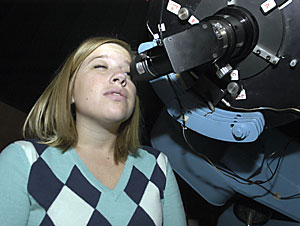 |
|
JOSEPH HESLING/Arizona Daily Wildcat
|
Retail and consumer science junior Meghan Powers views the planets Neptune and Uranus through telescopes provided by the Flandrau Center. Students can view the planets for free Wednesday through Saturday nights until early November.
|
|
|
By Adila Kunsa
Arizona Daily Wildcat
Wednesday, October 13, 2004
Print this
UA's Flandrau Science Center is featuring free public viewing of Uranus and Neptune on campus on their 16-inch telescope until early November.
Visitors can view the planets from Wednesday through Saturday, 7 p.m. to 10 p.m., weather permitting. The telescope is Arizona's only free public telescope open on a regular basis.
"It gives you a sense of perspective and your place in the universe," said Michael Terenzoni, planetarium coordinator at Flandrau.
The planets can be viewed between late September and early November every year.
So far, the turnout for the public viewings, which began in late September, has been a steady flow, Terenzoni said.
Kenneth Tindall, a civil engineering senior, said he didn't know about the public viewing until he saw the sign while walking home from a study session.
"I think it's awesome," Tindall said. "I didn't even know this existed until tonight."
Uranus and Neptune are called superior planets because they are outside of the Earth's orbit and are gas giants, made primarily of hydrogen and helium.
Uranus is about 1.8 billion miles from Earth and appears larger and brighter than Neptune, which is 2.7 billion miles from earth.
No details of the planets can be seen through the telescope except for bluish disks around them. The bluish color is the upper gas atmosphere, Terenzoni said. The planets are 20 degrees apart from each other in the southern sky.
"Sky Pilot" software makes it easy to find the planets in the sky, Terenzoni said. The software is essentially a guide or map of the sky that helps scientists angle the telescope. Terenzoni said "Sky Pilot" is the best planetarium computer software.
Uranus and Neptune became visible from Earth in 1980 and will be visible until about 2025, Terenzoni said. After 2025, the planets won't be visible again until the summer of 2145. Slowly drifting apart from each other, the planets were closest in 1993 when they were one degree apart.
The planets were closest to the Earth, or at their opposition, in August. When in opposition, a planet is opposite the Sun and closest to the Earth. This will be the closest the planets will get to Earth before continuing on their path away from it.
Terenzoni said it's important for the public to have the opportunity to look at these planets and the universe.
"Most people don't get to see Neptune and Uranus because they are obscure planets and usually ignored," he said.
Uranus and Neptune are not visible to the naked eye but can be seen with virtually any telescope, said Homer Hansen, one of the telescope operators at Flandrau.
All telescope operators are volunteers, including members of the UA and Tucson communities. Hansen is one of those community members who just enjoys looking at the night sky.
"It forces me to learn more about something I love," Hansen said. "I want to share it with people."
Hansen said Flandrau hosts anywhere from 60 to 80 people on the weekends.
Charlie Brown, a resident of Ohio, has visited the center five times before to view Mars, Saturn and Jupiter while visiting friends and family in Tucson.
Brown said he learns something new every time he visits the telescope.
"I think it's great and would like a telescope in my backyard to view things like this," Brown said.
Viewing will continue through early November at the Flandrau Science Center, 1601 E. University Blvd.
For more information call 621-STAR.
